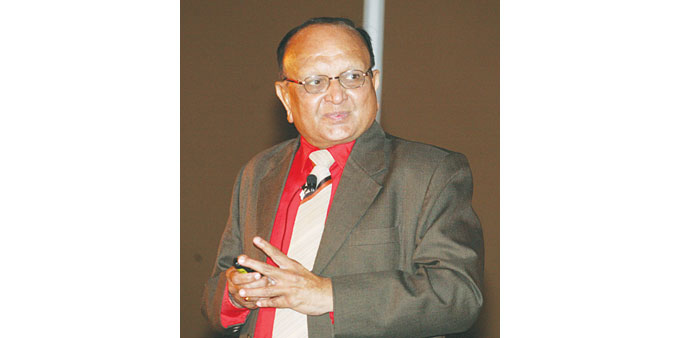|
|
A resourceful gas-rich nation like Qatar could emulate the successful strides that India has made in solar energy, Pranav R Mehta, chairman, the National Solar Energy Federation of India (NSEFI), has said.
An ardent advocate of solar energy, Mehta was in Qatar for the Solar Qatar Summit where he made a presentation, “Converting solar dreams into reality in India - Sharing the
Experience.”
An adviser to leading companies, including Areva Solar, Mehta pointed out that some of the regions - where India has made great advances in solar energy - have similar climatic and topographic conditions as that of Qatar and hence the latter could take a lesson or two from some of the successes that India achieved in such a short period.
“India made a small beginning in solar energy less than four years ago and in such a short time the country developed more than 2,080MW,” said Mehta while explaining the South Asian country’s march towards solar since 2009. Qatar which plans to develop 200MW of solar power by 2020, hopes to have one-third of its total installed power capacity from
solar by 2030.
“An extremely interesting potential exists for synergy in the area of solar energy between India and Qatar in view of India’s experience of having achieved 2.1GW solar capacity in a relatively short period of time, Qatar’s ambitious green energy plans as also the ongoing and future ambitious road map of India in solar energy,” said Mehta.
“We at the NSEFI are keenly looking forward to working together with Qatar in evolving a comprehensive solar plan - similar to the Jawaharlal Nehru National Solar Mission, launched in India in 2010,” said Mehta, who was recently in Germany on an invitation from the government there during the Indo-German Energy Forum dialogue.
In the discussions that Mehta had with some of the senior Qatari officials at the Solar Qatar Summit, he conveyed India’s interest in the issue, citing the similarities in climate, environs and topography among others. “The expertise of our skilled and qualified personnel could also be made use of in Qatar,” he said.
Qatar, as many other developing countries, is laying stress on education and capacity building and while developing its solar plans the country stands to gain considerably from its association with those who have made strides in the solar field in the last few years, added Mehta.
The NSEFI chairman said India is exploring the possibility of forming joint ventures between manufacturers from the Asian country and the polysilicon facilities being developed in
Ras Laffan.
In his presentation at the solar summit Mehta highlighted the successes achieved by India in building Asia’s first and largest solar park in Patan, Gujarat, with a target capacity of 500MW. “Already 219MW has been built and work is going on fast in the 2,000 hectare, earmarked for the project,” he said while recalling that the Gujarat state has built close to 840MW of solar power in less than four years.
In all, India has developed more than 29,465MW of renewable energy, of which 2,080MW is of solar power, which was completely built in the last three years.
“India’s target is 10,000MW by 2017 and 22,000MW by 2022 and we hope to reduce our reliance on naptha-propelled thermal plants in coming years,” said Mehta. As per the latest figures, thermal power occupies a major share (155,969MW) of the total installed power capacity of 230,000MW.

